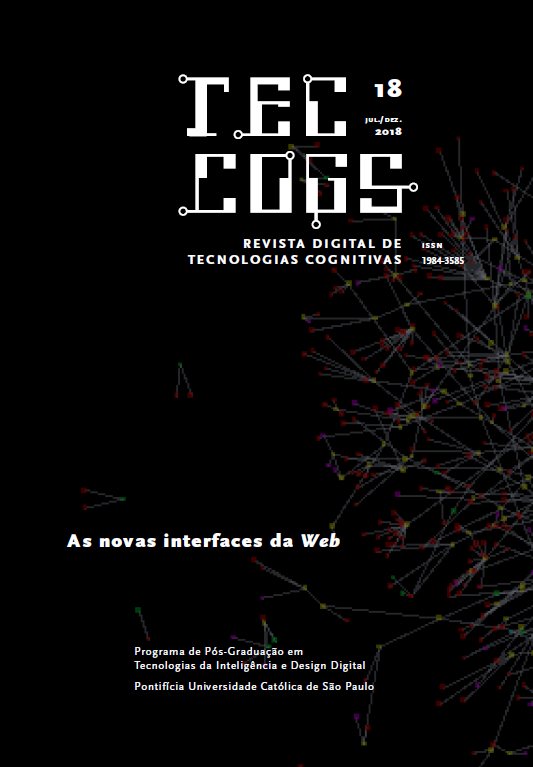Computational thinking as a learning strategy, digital authoring, and the construction of citizenship
DOI:
https://doi.org/10.23925/1984-3585.2018i18p94-109Keywords:
Computational thinking, Digital authoring, Citizenship, Learning strategyAbstract
Computational thinking in school is a didactic strategy to foster autonomous learning, which results in close didactic relationships between learners and teachers. The paper presents the details of this learning strategy in which digital authoring is implemented to construct citizenship. What the students learn is always a work in process. The paradigm of computational thinking aims at activities that focus on the development of critical thinking and self-reflective thought. Computational thinking supports continued discussions of the products of digital authoring in order to develop student autonomy and self-responsibility, which are essential competencies for lifelong learning.
References
BRENNAN, K., RESNICK, M. New frameworks for studying and assessing the development of computational thinking. Artigo apresentado no American Educational Research Association Annual Meeting, Vancouver, Canadá, 2012.
BURKE, Brian. Gamificar: como a gamificação motiva as pessoas a fazerem coisas extraordinárias. São Paulo: Dvs, 2015.
DORLING, M.; WALKER, M. Computing progression pathways, 2014. Disponível em: hoddereducation.co.uk/Subjects/ICT/Series-pages/ Compute-IT/Series-Box/Progression-Pathways/Progression-Pathways- Grid.aspx. Acesso em: 28 out. 2018.
DORLING, M.; SELBY, C.; WOOLLARD, J. Evidence of assessing computational thinking. IfIP 2015, A new culture of learning: computing and next generations. Vilnius, Lituânia. Disponível em: eprints.soton. ac.uk/377856. Acesso em: 01 nov. 2018.
KAFAI, Yasmin B.; PEPPLER, Kylie A.; CHAPMAN, Robbin (orgs.). The computer clubhouse. Nova Iorque: Teachers’ College Press, 2009.
LOPES, Rose (org.). Educação empreendedora: conceitos, modelos e práticas. Rio de Janeiro: Elsevier, 2010.
MCGONIGAL, Jane. A realidade em jogo: por que os games nos tornam melhores e como eles podem mudar o mundo. Rio de Janeiro: BestSeller, 2012.
OKADA, A.; MIKROYANNIDIS, A.; MEISTER, I.; LITTLE, S. Coaprendizagem através de REA e Redes Sociais. In: OKADA, A. Open educational resources and social networks: co-learning and professional development. Londres: Scholio Educational Research & Publishing, 2012. Disponível em: oer.kmi.open.ac.uk/?page_id=1479. Acesso em: 04 dez. 2018.
RICARDO, Eleonora Jorge. Educação a distância: professores-autores em tempos de cibercultura. São Paulo: Atlas, 2013.
SANTAELLA, Lucia. Comunicação ubíqua: repercussões na cultura e na educação. São Paulo: Paulus, 2013.
SELBY, C.; WOOLLARD, J. Computational thinking: the developing definition, 2013. Disponível em: eprints.soton.ac.uk/356481. Acesso em: 04 nov. 2018.
WAISELFISZ, Julio Jacobo. Lápis, borracha e teclado: tecnologia da informação na educação. Brasília: Rede de Informação Tecnológica Latino-americana (RITlA), 2007.
WING, J. Computational thinking. Communications of the acm, v. 49, n. 3, 2006, p. 33-35. Disponível em: dl.acm.org/citation.cfm?id=1118215.
Acesso em: 04 nov. 2018.
WING, J. Research notebook: computational thinking – what and why? The link. Pittsburgh: Carnegie Mellon, 2011. Disponível em: cs.cmu. edu/sites/default/files/11-399_The_Link_Newsletter-3.pdf. Acesso em: 04 nov. 2018.
Downloads
Published
How to Cite
Issue
Section
License
Copyright (c) 2018 Claudio F. André

This work is licensed under a Creative Commons Attribution 4.0 International License.
Esta revista oferece acesso livre imediato ao seu conteúdo de acordo com a licença CC BY 4.0, em conformidade com a definição de acesso público do Directory of Open Access Journals (DOAJ).
Ao submeter um texto à TECCOGS, os autores asseguram que o material submetido à avaliação e eventual publicação não infringe de modo algum qualquer direito proprietário ou copyright de outros. Com a submissão, o autor transfere em efetivo os direitos de publicação do artigo para a TECCOGS. A transferência de copyright cobre os direitos exclusivos de publicação e distribuição do artigo, incluindo reimpressões ou quaisquer outras reproduções de natureza similar, além de traduções. Os autores mantém o direito de usar todo ou partes deste texto em trabalhos futuros de sua autoria e de conceder ou recusar a permissão a terceiros para republicar todo ou partes do texto ou de suas traduções. Para republicar números da revista na íntegra, qualquer interessado precisa obter permissão por escrito tanto dos autores como também dos editores da TECCOGS. A TECCOGS por si só pode conceder direitos relativos a emissões de periódicos como um todo.
Imagens com direitos autorais pertencentes a terceiros, que não foram concedidos ao autor do texto, devem ser utilizadas somente quando necessárias à análise e ao argumento da pesquisa, sempre indicando as respectivas fontes e autoria. A TECCOGS dispensa o uso de imagens meramente ilustrativas. Se desejar ilustrar um conceito, o autor deve indicar, em forma de URL ou referência bibliográfica, uma referência em que a ilustração esteja disponível.
---------------------------------------------------------------------------------
This journal offers free immediate access to its content under CC BY 4.0, in accordance with Directory of Open Access Journals' (DOAJ) definition of Open Acess.
When submitting a text to TECCOGS, authors ensure that the material submitted for evaluation and eventual publication does not infringe any proprietary right or copyright. Upon submission, authors effectively transfer the publication rights of the article to TECCOGS. The copyright transfer covers the exclusive rights of publication and distribution of the article, including reprints or any other reproduction of similar nature, in addition to translations. Authors retain the right to use all or parts of the text in future works of their own, as well as to grant or refuse permission to third parties to republish all or parts of the text or its translations. In order to fully republish issues of the magazine, anyone interested must obtain written permission from both the authors and the editors of TECCOGS. TECCOGS alone can grant rights relating to issues of journals as a whole.
Images whose copyright belongs to third parties that have not been granted to the author of the text should be used only when essential for the analysis and argument, always indicating theirs respective sources and authorship. TECCOGS dismisses any use of merely illustrative images. To illustrate a concept, the author must indicate, in the form of a URL or bibliographic reference, a source in which the illustration is available.


